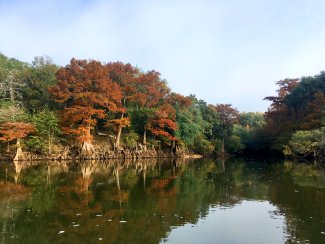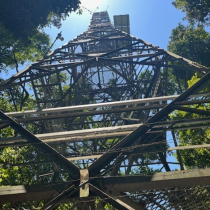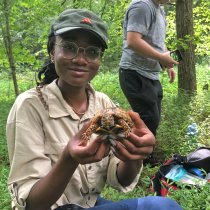Getting to Know Our Site Hosts: The Jones Center at Ichauway
June 7, 2023
The NEON program would not be possible without the support of our site hosts. Nestled within the heart of Georgia's longleaf pine ecosystem, the Jones Center at Ichauway serves as a prime example of these crucial partnerships. NEON staff ecologist Rhea Esposito recently interviewed Senior Research Associate Scott Taylor about the relationship between NEON and the Jones Center.
The Jones Center at Ichauway is the host for NEON's JERC (Jones Ecological Research Center) terrestrial field site in Domain 03 – the Southeast. The 29,000-acre preserve in rural southwest Georgia, located in the Flint River basin in the Ichawaynochaway watershed region, was set aside in the 1990s as a research and conservation center focused on the ecology, restoration, and management of the longleaf pine ecosystem. Originally established as a quail hunting reserve in the 1920s by Coca-Cola Chairman Robert Woodruff, Ichauway is home to one of the largest remaining tracts of mature longleaf pine and wiregrass habitat in the Southeast. This unique fire-adapted ecosystem is maintained through a controlled burning regimen. The Jones Center at Ichauway now supports a wide range of research and conservation activities focused on forest ecology, aquatic ecology, hydrology, and the relationships between wildlife species and their habitat.
NEON's JERC field site occupies roughly 3500 acres in the southwest corner of Ichauway and transitioned to full operations in 2015. It supports a 6-level instrument tower and multiple field sampling plots. It is colocated with the Flint River (FLNT) aquatic site.
The following interview has been lightly edited for clarity and length.
Can you speak a little bit about the history of the Jones Center and NEON?
Robert W. Woodruff, a CEO of Coca-Cola, bought the land as a plantation for quail hunting back in the 1920s. When he passed away, he left it to his foundation to be protected. The foundation decided to create this ecological research center. They brought in a scientific advisory crew, put in some temporary buildings at the old site, and then started building these new facilities in the early to mid 90s. We still have a quail hunting operation – no pay hunts, invited guests only – which is really what's protected this property. If it wasn't for quail and quail hunting, most of southwest Georgia would be taken up by center pivot irrigation agriculture like you see around this region. So the quail really saved this ecosystem, especially in this area.
Prior to establishing a NEON site, the former director here, Dr. Lindsay Boring, and Dr. Steve Golladay were on some of the original steering committees for what would become NEON. Around 2012, we got into the agreement to have a relocatable [gradient] site under a five-year agreement. NEON started construction on the tower soon after that and started collecting preliminary data. The tower came online in late 2012 or early 2013. I've been in charge of hosting the NEON site here since then… I can't believe it's been 10 years. We just renewed this past summer for another five years with NEON.
How long have you been working at the Center?

Scott Taylor, researcher and NEON liaison at the Jones Center.
I've been at the Center for 20 years. I started in February 2003 as a research technician – my first position after a Master's degree from Auburn University. I started in the forest soils lab with biogeochemical cycling, looking at nitrogen and legumes and nitrogen cycling. After a few years in the soils lab, I kind of shifted gears to the carbon sector and carbon flux towers; NEON has a flux tower here. We've hired many new scientists and started several new labs… I've been in the silviculture lab now for a couple of years managing that.
So, I really wear three hats. I'm a lead research technician in the silviculture lab where I handle the day-to-day operations of the lab and the field workers. I'm also the supervisor for the central lab facilities and the central analytical lab as a whole. And then I'm the NEON liaison for the Jones Center. So, I'm the kind of go between for all of these groups.
What work goes on at the Jones Center?
We have eight labs right now. We have wildlife biology. We have aquatic ecology, herpetology, entomology, ecohydrology. We have landscape ecology, and then silviculture. And we have plant ecology. So, we have a lot of different labs. Each one of those has projects internally funded by the Center; scientists are also encouraged to go out and get grants for other stuff. Total persons here fluctuate between 80 and 100, with permanent staff being most of that. We also get grad students here and some seasonal technicians that are here for around three months.
What do you feel are some of the benefits of the collaboration with NEON?
For many years prior to NEON, the scientists here already had their niches and were doing their own research, and much of that data overlapped with what NEON proposed to collect. For instance, we had a wildlife biologist collecting small mammal data, and aquatics people collecting data about the stream; we were already kind of doing a lot of these things. So originally, the biggest draw for us was the Airborne Observation Platform (AOP). Getting that airborne lidar really doesn't cost us anything, so it's a great benefit that still allows us manage the Center the same way we had been. To collect high quality data like that ourselves would eat up an enormous budget. To have that AOP data collected four out of every five years or so was really a draw for our scientists.

FLNT river aquatic site in the fall
We've also been able to point to our experience with NEON as an advantage in other areas. Because the NEON footprint is only on a small portion of Center, we can supplement what NEON is doing with our own research, and vice versa, to compare the data. So, we're starting to see where we can leverage that benefit a little more, including in applying for grants and funding.
Another great benefit is that we're increasing our pull for graduate students. We already had a pretty big graduate program, but we're starting to build it more. Having NEON here gives grad students a bigger platform, a whole other suite of data and locations in the Observatory they can use to get preliminary data, or to supplement data they collect here. We've also had a couple of researchers who have looked into the NEON Assignable Assets program to explore those possibilities. NEON in general expands our scientific reach here at the Center.
What is the most exciting thing that has come out of the NEON collaboration?
Again, I would go back to the AOP. I believe in 30 years, we're going to realize that this observation platform is something like the Hubble telescope, or something that NOAA does in the deep sea. Over a long period of time, it turns into something we can look back at and have these ecological metrics on a huge scale. It was arduous to design and finally implement, but in the end, we'll be able to say that we're able do much better forecasting, or we were able to make changes or decisions for the better, because we have these long term, high quality datasets. The Jones Center being a part of that, I think, is like a feather in our research cap.
What are some of the challenges of a place like the Jones Center?
NEON-specific challenges? Our main challenges are people and time. Those exist for almost any organization, I think, along with money concerns; but as I said, NEON doesn't really cost us anything. For us, it's mostly the coordination. We want to be good hosts for NEON, but we also have long-term permanent researchers and educators, and it's a lot to coordinate.
Take our prescribed burning for example. When you're trying to burn 12,000 acres a year, a lot of things have to happen. The burn crew has to decide where to burn, secure a burn permit every morning by 7 am, and then go in and burn it. Without coordination, incidents can happen like when we burned up some NEON litter traps. When we burn around the NEON tower, I'll try to be out there helping and making sure that everything looks secure before they start burning. So coordinating that kind of stuff when the people aren't here is difficult, especially if I'm busy doing my own research. So yes, time and people management has been the biggest challenge that we've had.

Top of NEON's flux tower at the JERC field site, at the Jones Center
As part of the coordination, I like to meet with the NEON people just so I know them if something happens, and I know who I'm talking to. We do a little orientation forum where I make sure they know who they can call if they can't get me if there are any concerns or issues, or if they get stuck with a dead battery, flat tire, etc. So it's mostly those kinds of moving parts.
Do you try to meet all the NEON staff there?
I do try to meet all of them. I might not meet some of the ones who are here for a very short time. But NEON people who have been here a long time know everything they need to, and they can help the new people. They know the property, they know the rules. They know when we are quail hunting or doing management activities. That's made it a lot easier, when I trust them and don't feel like I need to meet every single new person. But I try to meet the people that are going to be coming up here regularly.
What are the big outreach events here? How important is community?
We do some small events where we bring in some landowners, or a prescribed burn council, or something like that. But we're excited to be back to doing our big open house, which we've done every other spring since 2001, excluding the COVID-19 years. If it's a good year, 900 people will be here. We invite the public to spend some of the day here, with some food trucks and a picnic for hanging out, and they learn about the Center and the environment. This year, for the first time, Baker County is bringing their entire high school in the morning to tour the lab – 70 students, 9th through 12th grade. Our mission has never really been K through 12; we've always focused on undergrads and bringing in teachers and undergrads, so this is new and exciting. They'll learn about the ecosystem as a whole and the Jones Center, and hopefully leave with a better understanding of longleaf pine ecology.
We also try to reach out to teachers as much as we can, and each scientist probably does this in their own realm. We used to do Endowment for Education Research Award (EERA) events where they would actually come and stay a while. EERA was a good program, an award to support specific education research projects. Educators would come and spend a week here or at other similar locations, learn about forestry and plants and, at the end of the week, present a curriculum of sorts that they think would be good for their students. That stopped here probably mid 2010, but it was a good time, and it was fun for us to interact with them.
Also, as the largest employer in the county – excluding the county government – the sense of community is strong here. 29,000 acres takes up a pretty good part of the county, too. We don't get a lot of county services, so we scrape our own on roads, we have our own volunteer fire department, we have our own security. It's a good community, like a family. I mean, I've been here 20 years. My wife is from here. I grew up about as far north of Albany, Georgia as we are south of it, but I'm at home. Once people get here, they usually find it hard to leave.
Appreciation for Our Site Hosts
Thank you to Scott Taylor and all of the researchers at the Jones Center at Ichauway who support our work at the NEON program. Our site hosts give us access to diverse ecosystems, provide local knowledge and on-the-ground support, and connect us with local communities and ongoing research activities. The research and conservation work conducted at Ichauway is vital to our ongoing mission. We look forward to our continued partnership in the years to come.
The Jones Center at Ichauway works to understand the natural systems of the southeastern Coastal Plain through research, demonstrate excellence in natural resource management through conservation, and promote their science and management through education and outreach programs. Learn more about the Center at www.jonesctr.org/.


